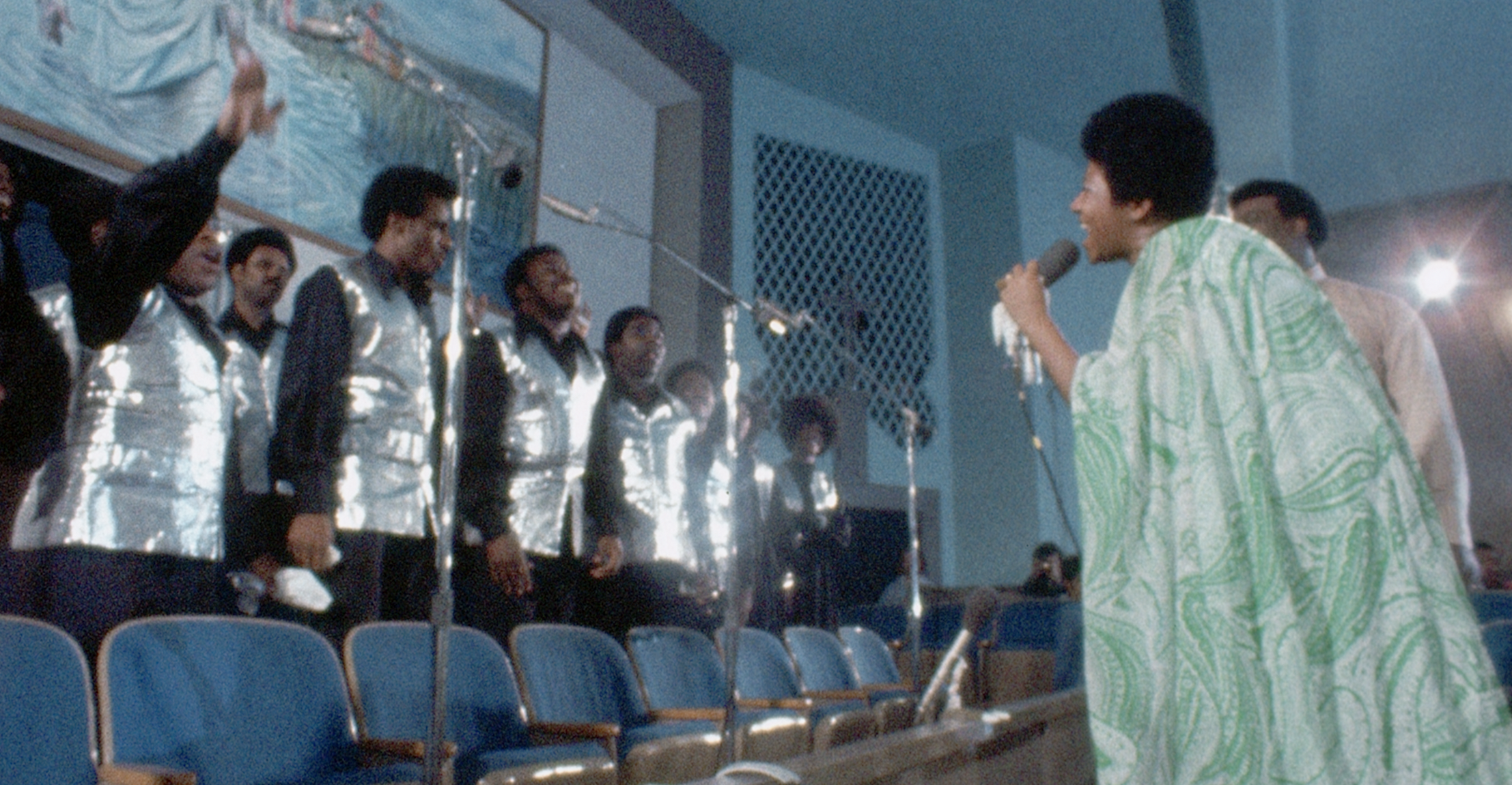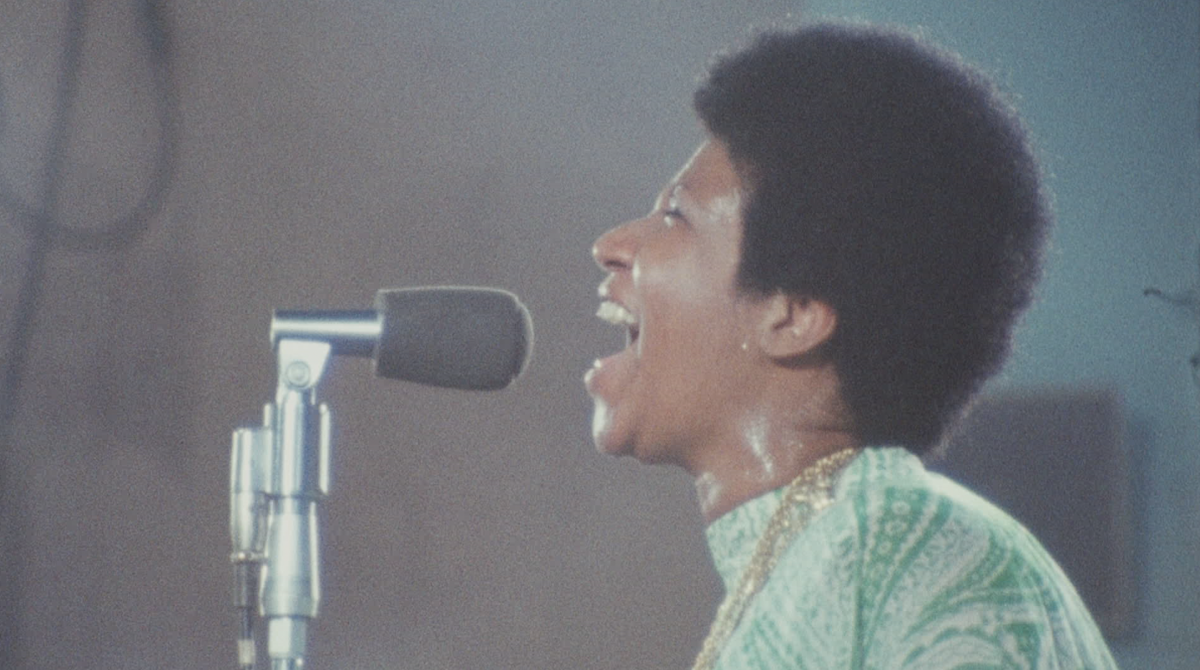With all the holy days around this time of year, there is plenty of talk of capital-M miracles. But there’s another wonder — much smaller in scale than the parting of the Red Sea or Jesus rising from the dead, but miraculous nonetheless — coming to a theater near you.
It’s a resurrection nearly 50 years in the making, as the film companion to Aretha Franklin’s legendary 1972 Amazing Grace live gospel album, shelved for decades due to technical problems and legal disputes, finally enters wide release. The record is a classic — the biggest-selling of Franklin’s career and to this day the best-selling live gospel album of all time — and the original plan was for Warner Brothers to supplement it with a concert film shot by Sydney Pollack, documenting Franklin’s performance at the New Temple Missionary Baptist Church in Los Angeles. But Pollack’s crew neglected to bring a clapperboard, a mistake that left the film’s audio and video out of sync.
Producer Alan Elliott first learned of the Amazing Grace footage’s existence in 1990 when he was working as an A&R man at Atlantic Records, setting off a decades-long quest to help it see the light of day. Though there were plenty of setbacks along the way, Elliott remained determined (even mortgaging his house to buy the footage from Warner Brothers) and never lost faith in the project.
“I never felt like the movie wouldn’t come out,” Elliott tells InsideHook. “It was sort of like, ‘oh, I’ve got a car! Oh, there’s a road. Oh, let’s go down that road. Oh, there’s a stop sign. Oh, there’s a guy that walked in front of me. Oh my god, we got a flat tire!’ You know? But it was never like ‘We’re not gonna make it.’ It’s just sort of like, ‘Oh, all right, we’ll have to deal with that.’ And there were a lot of them. But there was never a thing where I said no, it was never going to happen. Never, ever ever.”
Elliott met Pollack in 2007, a year before the Oscar-winning director succumbed to pancreatic cancer. The two discussed putting out Amazing Grace, but Pollack neglected to mention one key issue.
“He never told me about the audio sync issue,” Elliott says. “I’ll continue on my analogy. We’d be driving down the road and go, ‘Oh, we’re out of gas.’ ‘You didn’t tell me we were out of gas. The thing says full.’ ‘Oh yeah, the gas meter doesn’t work.’ Sydney Pollack and I had many, many conversations, and they were all theoretical, and I got frustrated at a certain point because I wanted to see the stuff. And he would never show me the stuff. He would say, ‘Oh, Aretha had a contract problem’ or this and that, and I was like ‘Okay, where’s the footage?’ And it was only after he passed away that we found a memo that said ‘We’ve hired the choir director as the lip reader.’ And that started a different chain of you know, how are we gonna fix this one? Because it was like, ‘Oh, what? Why would they hire the guy as a lip reader?’”
Fortunately, with modern technology, a lip-reader isn’t necessary to sync audio with video, and after three weeks of work, Elliott’s team had between 13 and 14 hours of useable footage to sift through — something he knows would please Pollack.
“About two or three months ago, I was at the Palm Springs Film Festival and Sydney’s assistant, a woman named Donna Ostroff came to see the movie, and she said to me, ‘I never told you this,’” he recalls. “And I said, ‘what is it?’ She said, ‘Well, in between projects, Sydney would call Warner Brothers and have them send the film over so we could watch it in the dark without sound.’ And it’s like ‘Oh, that’s a sad image.’ And I know he wanted to finish it, and he was so gracious to me. He was really such a sweet man. He trusted me with what he started, and it’s always meant a lot.”
The finished product is a stunning portrait of an artist at the height of her powers, putting Franklin’s performance front-and-center. Determined to “stay in the room” and let the music speak for itself, Elliott decided to skip any talking head interviews à la The Last Waltz, and borrowed a familiar format to accentuate the drama of the soul legend’s vocals.
“I come from musical comedy and musical theater, and the idea of structure of musical comedies is just in my DNA, and so we stole it,” he says. “I mean, we just totally took the idea, which is the start of the movie is the introduction of all the characters in the first scene, and then you have a song, and that introduces what their intentions are, which is ‘We Are On Our Way,’ and then you go into what in the theater they call an ‘I wish’ song, and that’s ‘Wholy Holy,’ and then you go into ‘What A Friend We Have In Jesus’ which is an uptempo number, and you have a big end of the first act song, which is ‘Amazing Grace,’ and then you have the 11 o’clock closing number which is ‘Never Grow Old,’ and you have the everybody-comes-out-for-a-bow number which is ‘Old Landmark,’ and it’s completely pilfered from musical theater tradition.”

It may not be original, but it’s effective, and Elliott’s decision to keep the camera inside the church allows viewers to watch members of the congregation react to Franklin—crying out, dancing in the aisles, even weeping. Franklin reportedly was pleased with film, but Elliott hit another roadblock when she sued, in 2011 and again in 2015, to prevent him from screening it.
“I never got into the thing to poke a finger in the eye of Aretha Franklin,” he says. “So it’s almost like this weird Freudian thing of like ‘Mom, look what I’m making for you, look what I’m making for you!’ and then you’re sort of the abused child where she goes ‘No, I don’t want to deal with that.’ So it was really heartbreaking at the time. But later I found out that she had pancreatic cancer, and I had known that I’d made a movie that was really a defining moment in her career and it had her father [Rev. C.L. Franklin], and the last song of the movie is the first song she ever recorded, and she was dying over eight years with pancreatic cancer, and I understood. At the time, it was very painful, because you don’t have that information, and [you think], ‘why does she not want the movie out? She said she loved the movie. If she said she loved the movie, why doesn’t she want the movie out,’ you know?…But when I was told that she had pancreatic cancer, it made sense, and we decided to sit on the movie for a couple years because she wasn’t well. It was heartbreaking, and there was nothing to do about it.”
Elliott stayed in contact with Franklin’s niece, Sabrina Owens, the executor of her estate, throughout the years. When Franklin eventually passed away last August, Owens invited him to attend the funeral in Detroit.
“A couple weeks later, Sabrina asked us to come show the movie to the family, and it was a really emotional evening,” Elliott says. “Everybody got to not just see Aretha but see Aretha when she was 29 years old, and not just see Aretha when she was 29 years old, but see their grandfather on film in that way and to be able to see that record, and so whatever I hadin terms of my experience, they were having it that much more profoundly. They were so excited, and we’d offered them I hope a little relief in terms of their profound loss of a family member and really the matriarch of that world. So I think the movie offers that for her fans now in the same way that it offered it for her family the night that we showed it in Detroit.”
Fans will finally be able to experience Amazing Grace, but the miracles keep coming even after the film hits theaters; Elliott recently learned that 10 extra reels of footage were found.
“It doesn’t surprise me,” he says, laughing. “There’s been so many crazy stories about this over the years that why not?…So we’ll see what’s there. Like everything else with this movie, it’s insane.”
This article appeared in an InsideHook newsletter. Sign up for free to get more on travel, wellness, style, drinking, and culture.

























